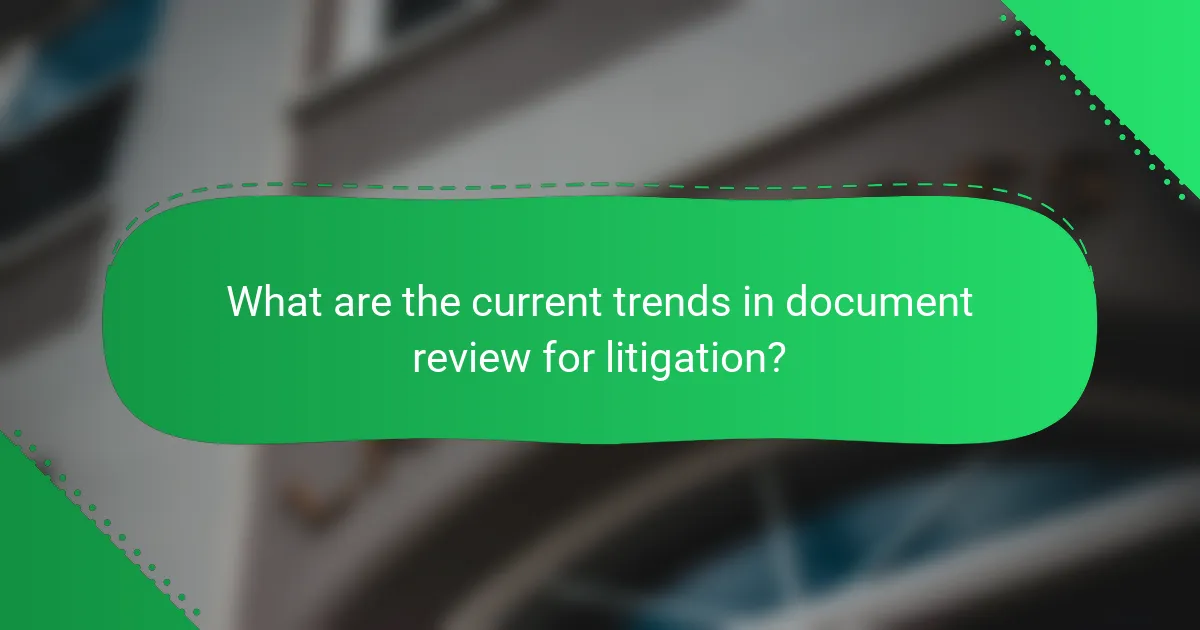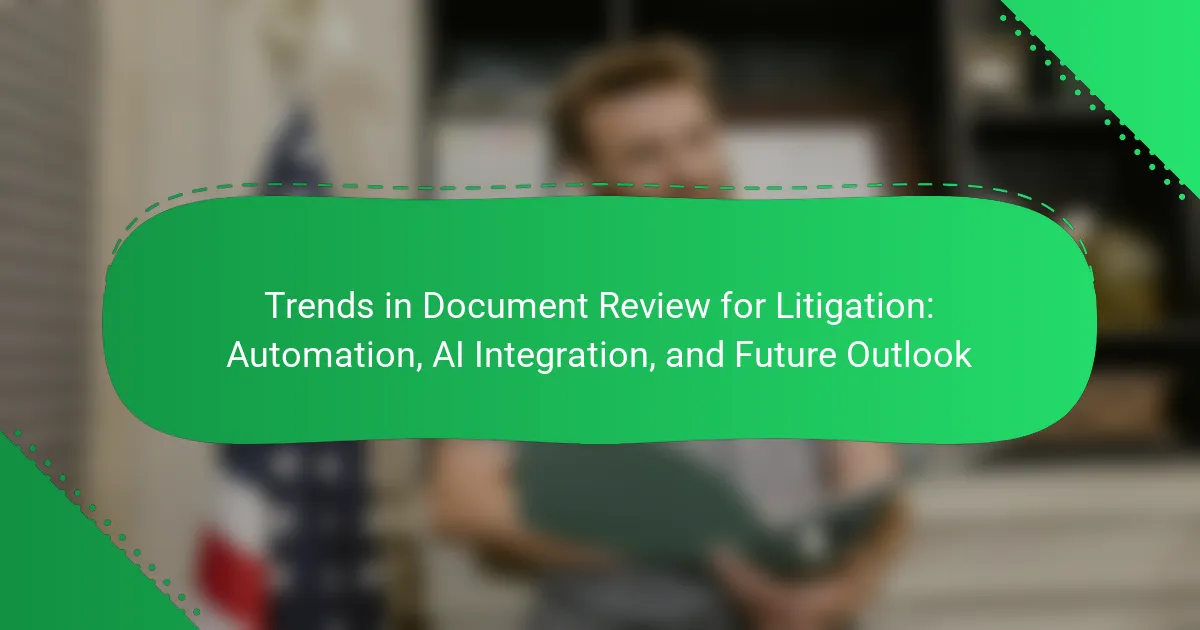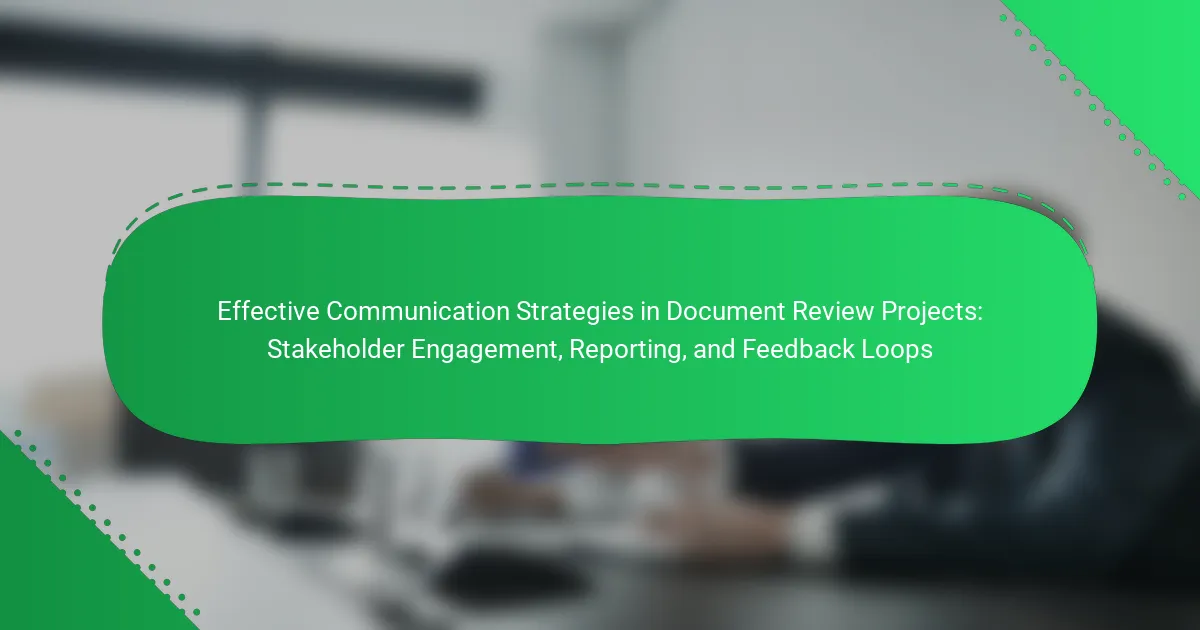The main entity of the article is document review for litigation. Current trends in this area highlight the increased use of automation and artificial intelligence (AI) to enhance efficiency and accuracy. Automation is streamlining the review process, significantly reducing both time and costs, while AI improves document analysis through advanced techniques like predictive coding. Additionally, the rise of remote collaboration tools is facilitating effective teamwork across distances, and there is a heightened focus on data security and compliance during document handling. These developments indicate a transformative shift toward more technologically advanced practices in litigation.

What are the current trends in document review for litigation?
Current trends in document review for litigation include increased automation and integration of artificial intelligence (AI). Automation streamlines the review process, reducing time and costs. AI enhances document analysis, improving accuracy in identifying relevant information. Predictive coding is becoming more common, allowing machine learning algorithms to assist in sorting documents. Remote collaboration tools are also gaining traction, enabling teams to work effectively across distances. Additionally, there is a growing emphasis on data security and compliance during document handling. These trends indicate a shift towards more efficient and technologically advanced litigation practices.
How is automation influencing document review processes?
Automation is significantly enhancing document review processes by increasing efficiency and accuracy. It streamlines the handling of large volumes of documents. Automated systems can quickly identify relevant information using algorithms. This reduces the time lawyers spend on manual review. A study by the RAND Corporation found that automation can decrease document review costs by up to 50%. Additionally, automation minimizes human error in the review process. It allows for more consistent application of legal standards. Overall, automation transforms traditional document review into a faster and more reliable process.
What specific automation tools are being utilized in litigation?
Specific automation tools utilized in litigation include e-discovery platforms, document management systems, and case management software. E-discovery platforms like Relativity and Logikcull streamline the process of identifying, collecting, and analyzing electronic documents. Document management systems, such as iManage and NetDocuments, help organize and store legal documents efficiently. Case management software, including Clio and MyCase, assists lawyers in managing case details and client communications. These tools enhance efficiency and accuracy in litigation processes.
How does automation improve efficiency in document review?
Automation improves efficiency in document review by streamlining the process of analyzing large volumes of documents. It reduces the time required for manual review by automating repetitive tasks. Automated systems can quickly identify relevant documents based on predefined criteria. This leads to faster retrieval of information and improved accuracy in identifying key data. According to a study by the RAND Corporation, automated document review can reduce costs by up to 80% compared to traditional methods. Furthermore, automation minimizes human error, ensuring more consistent outcomes in document assessments. Overall, these efficiencies contribute to a more effective and timely litigation process.
What role does AI integration play in document review?
AI integration enhances document review by automating the analysis of large volumes of data. It improves efficiency by quickly identifying relevant documents and reducing manual labor. AI algorithms can categorize documents based on content, context, and relevance. This technology minimizes human error and speeds up the review process significantly. Studies show that AI can reduce document review time by up to 70%. Furthermore, AI tools can learn from previous reviews, improving their accuracy over time. Overall, AI integration streamlines workflows and allows legal teams to focus on strategic decision-making.
How are AI technologies transforming the accuracy of document review?
AI technologies are enhancing the accuracy of document review through advanced algorithms. These algorithms can analyze large volumes of documents quickly and efficiently. They utilize natural language processing to understand context and identify relevant information. Machine learning models improve over time by learning from user interactions and feedback. This leads to reduced human error in document analysis. AI can also flag inconsistencies and anomalies that may be overlooked by human reviewers. Studies indicate that AI can increase review accuracy by up to 30%. Legal firms adopting AI tools report significant time savings and improved outcomes in litigation processes.
What are the challenges associated with AI integration in litigation?
AI integration in litigation faces several challenges. Data privacy concerns arise due to sensitive information involved. Compliance with legal standards is essential but can be complex. The accuracy of AI algorithms is crucial; errors can lead to significant legal repercussions. Resistance from legal professionals often occurs due to fear of job displacement. Implementation costs can be high, limiting access for smaller firms. Additionally, the need for ongoing training and updates for AI systems presents operational challenges. These factors collectively hinder the seamless adoption of AI in the legal field.
What are the future outlooks for document review in litigation?
The future outlooks for document review in litigation include increased automation and AI integration. Technology will streamline the review process, enhancing efficiency and accuracy. Machine learning algorithms will analyze documents faster than human reviewers. Predictive coding will assist in identifying relevant documents based on past cases. This shift is expected to reduce costs associated with document review. A 2022 report from the International Legal Technology Association indicates that 80% of firms plan to invest in AI tools for litigation support. As a result, legal professionals will focus more on strategic decision-making rather than manual document review tasks. The trend towards remote work will also influence how document review is conducted, promoting cloud-based solutions. Overall, the landscape of document review in litigation is evolving towards a more technology-driven approach.
How might emerging technologies shape the future of document review?
Emerging technologies will significantly enhance the future of document review. Automation tools will streamline the review process, reducing time and labor costs. Artificial Intelligence (AI) will improve accuracy by identifying relevant documents more efficiently. Machine learning algorithms can analyze patterns in data, providing insights for better decision-making. Natural language processing will enable systems to understand context, leading to more precise document categorization. These advancements will likely result in faster case resolutions. A study by Deloitte found that AI can reduce document review time by up to 50%. Overall, emerging technologies will transform document review into a more efficient and effective process.
What trends are expected to dominate the document review landscape in the next decade?
Automation and AI integration are expected to dominate the document review landscape in the next decade. These technologies will significantly enhance efficiency and accuracy in legal processes. Automation will streamline repetitive tasks, reducing the time lawyers spend on document review. AI tools will improve data analysis, identifying relevant information faster than traditional methods. The use of machine learning will enable systems to learn from past reviews, increasing their effectiveness over time. Additionally, predictive coding will become more prevalent, allowing for smarter document categorization. These trends reflect a broader shift towards digital transformation in the legal industry. As firms adopt these technologies, they will likely see cost reductions and improved outcomes in litigation.
How can legal professionals adapt to these trends?
Legal professionals can adapt to trends in document review by embracing automation and AI technologies. They should invest in training programs to enhance their understanding of these tools. Implementing AI-powered document review software can increase efficiency and accuracy. Additionally, legal professionals must stay updated on emerging technologies through continuous education. Collaborating with tech experts can facilitate smoother integration of new tools. Adopting a flexible approach to workflows will help accommodate changes in technology. Finally, participating in industry forums can provide insights into best practices and innovations.
What best practices should be implemented for effective document review?
Effective document review requires a systematic approach. Establishing clear objectives is crucial for focusing the review process. Utilizing technology, such as AI tools, can enhance efficiency and accuracy. Implementing a standardized review checklist ensures consistency across documents. Regular training for reviewers improves their skills and understanding of the process. Maintaining open communication among team members facilitates collaboration and problem-solving. Periodic audits of the review process help identify areas for improvement. Lastly, documenting findings and decisions creates a valuable reference for future reviews.
How can professionals stay updated on advancements in document review technologies?
Professionals can stay updated on advancements in document review technologies by subscribing to industry journals and newsletters. These publications often feature the latest research and developments in the field. Attending conferences and workshops also provides opportunities to learn from experts and network with peers. Online webinars and training sessions are valuable for gaining insights into new tools and methodologies. Engaging in professional organizations or forums can facilitate discussions about emerging trends. Following key influencers and thought leaders on social media keeps professionals informed about real-time updates. Regularly reviewing case studies helps in understanding practical applications of new technologies. Lastly, participating in online courses can enhance skills related to document review technologies.
The main entity of the article is document review for litigation. The article outlines current trends in this field, highlighting the impact of automation and artificial intelligence (AI) on efficiency and accuracy. It discusses specific automation tools, the role of AI in improving document analysis, and the challenges associated with AI integration. Additionally, the article explores future outlooks for document review, emphasizing the expected dominance of automation and AI technologies in the next decade, and provides best practices for legal professionals to adapt to these advancements.



